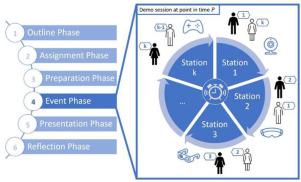mastering VR/AR integration: Overcoming Curriculum Challenges in Education
Virtual Reality (VR) and Augmented Reality (AR) are revolutionizing modern education, offering immersive experiences that foster deeper engagement and understanding. Educators and institutions worldwide are exploring VR/AR integration, but adapting these emerging technologies into existing curricula poses unique challenges. In this article, we’ll unravel the key obstacles, spotlight proven benefits, and share practical strategies for successfully implementing VR/AR in the classroom.
Why VR/AR Integration matters in Education
VR/AR technology for education allows students to step beyond textbooks and enter a dynamic, interactive digital world. By simulating real-life scenarios, complex concepts become accessible, actionable, and engaging.
- Experiential Learning: Students can virtually explore past sites,conduct scientific experiments,or practice language skills in context.
- Enhanced Retention: Interactive experiences significantly improve knowledge retention.
- inclusive learning: VR/AR can accommodate various learning styles and accessibility needs.
- Remote Collaboration: Connected worlds foster global interaction, breaking down classroom walls.
Curriculum Challenges: What Stands in the Way?
Integrating VR/AR into educational curricula is exciting—but far from straightforward. Here are the principal roadblocks educators face:
- Resource Constraints: Not every school has access to VR headsets, AR-compatible devices, or high-speed internet.
- curricular Alignment: VR/AR experiences must fit learning objectives, standards, and assessment frameworks.
- Teacher Training: Educators need guidance to confidently use and create VR/AR content.
- Content Quality: Reliable, pedagogically sound VR/AR apps are limited, making lesson planning challenging.
- Student Accessibility: Ensuring all learners—including those with disabilities—can participate meaningfully is essential.
- Integration Complexity: Aligning technologies with LMS platforms (like Moodle or Canvas) and existing classroom practices can be daunting.
Proven Benefits of VR/AR in Education
Despite the hurdles, VR/AR integration in education delivers transformative outcomes:
- Improved Engagement: Gamified, visually stimulating tasks make learning fun and memorable.
- Contextual Understanding: Students gain practical skills through high-fidelity simulations (e.g., medical procedures, architectural modeling).
- Real-Time Feedback: Many VR/AR platforms allow instant performance assessment, supporting formative learning.
- Empathy building: Immersive experiences foster empathy for diverse perspectives, cultures, and histories.
Practical Tips for VR/AR Curriculum Integration
Overcoming curriculum challenges requires strategic planning and creative problem solving. Here’s how educators can master VR/AR integration:
1. Start Small and Scale Gradually
- Pilot with low-cost AR apps (smartphones/tablets) before investing in full-scale VR solutions.
- Select one or two subjects—such as science or history—for initial implementation.
2. Align VR/AR Activities with Learning Objectives
- Use backward design planning: begin with curriculum goals, then find or build VR/AR experiences that support them.
- Ensure activities reinforce both skills and content knowledge.
3. Foster Teacher Professional Advancement
- Invest in workshops and online courses on VR/AR pedagogy and technology troubleshooting.
- Encourage collaboration among teachers to share best practices and resources.
4. Prioritize Accessibility and Inclusion
- Choose VR/AR platforms compatible with assistive technology (screen readers, adjustable interfaces).
- Offer flexible alternatives for students unable to use headsets.
5.Integrate with Existing tech Infrastructure
- Ensure compatibility with Learning Management Systems (LMS) and school networks.
- Test software and hardware with IT support to prevent disruptions.
6. Involve Stakeholders Early
- Engage students for feedback and ideas about VR/AR opportunities.
- Work with parents and administrators to address safety and privacy concerns.
Case Studies: Real-World Success Stories
Merging History and VR: Colonial Williamsburg
A US-based school implemented VR field trips to Colonial Williamsburg, allowing students to explore 18th-century Virginia in immersive detail.Teachers noted improvements in history comprehension and student engagement, with learners asking deeper questions and linking historical events to modern challenges.
AR Chemistry Labs: Safer Experimentation
In the UK, secondary science teachers used AR apps to simulate chemical reactions, letting students “mix” compounds and observe outcomes without hazards. The approach not only improved safety but also allowed students to repeat experiments and analyze variables, leading to boosted retention rates and more confident lab skills.
VR Language Learning in Japan
A Japanese language school adopted VR conversation modules, enabling learners to practice in virtual cafes and markets. Students reported reduced anxiety and greater conversational fluency, demonstrating the power of context-rich immersive practice.
First-Hand Experience: Educator Voices
“When our district started using AR in science classes, students who once struggled to grasp abstract processes now express excitement for learning. We saw a 20% rise in science scores after just two semesters. The key is starting simple and supporting teachers every step of the way.”
– Anna Lopez, Middle School Science Teacher
“VR has transformed how I teach history. Students visit ancient cities virtually, connect artifacts to their narratives, and even create their own storylines. The curriculum is richer—and classroom discussions have leveled up.”
– Raj Patel, High School History Instructor
Best Practices: Ensuring Long-Term Success
- Keep Content Updated: Technology evolves rapidly. Regularly review VR/AR apps and platforms for relevance and security.
- Monitor Impact: Use formative and summative assessments to track how VR/AR affects engagement and learning outcomes.
- Encourage Student Creation: Let learners design VR/AR experiences, fostering creativity and digital literacy.
- Build Partnerships: collaborate with technology companies, universities, or local museums to enhance resources and expertise.
Conclusion: Embracing the Future of Learning
mastering VR/AR integration in education requires more than technological adoption—it demands thoughtful curriculum design, teacher empowerment, and inclusive practices. By overcoming resource, alignment, and accessibility challenges, educators can unlock extraordinary opportunities for interactive, student-centered learning. As schools continue to embrace immersive technologies, a new generation of engaged, empathetic, and digitally savvy learners is on the rise.The time to reimagine the future of education is now—one immersive experience at a time.

